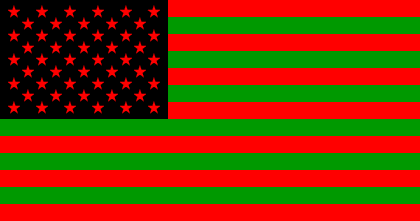

- #GREEN RED AND BLACK FLAG DRIVERS#
- #GREEN RED AND BLACK FLAG DRIVER#
- #GREEN RED AND BLACK FLAG FULL#
75% race time/distance - Full points awarded.Laps 1 - 2 - The race is considered to have been abandoned and no points are awarded.There are various permutations with regards to what happens if a race is suspended and ultimately stopped by a red flag at different times during the race: ProcedureĪn E-Prix may either be restarted or ended after a red flag period, depending on the timing of the red flag in relation to the race time. Furthermore, the race time is stopped the moment the red flag is deployed, with the order of the field restored to how it had been the lap before the red flag was shown.
#GREEN RED AND BLACK FLAG DRIVERS#
In that instance the drivers are instructed to enter the pitlane and queue in the pits, with teams then allowed to work on the cars if permitted by the FIA. Red flags may be deployed if an incident cannot safely be covered under VSC or SC conditions, or would take a long time to clear and make the circuit safe again. Under full Safety Car conditions drivers are instructed to line-up behind the safety car, and follow the SC around until the incident has been cleared.

In the first instance the entire circuit is covered by yellow flags, meaning drivers cannot overtake and must match a specific lap time delta, meaning gaps are maintained between cars. VSC/Full Course Yellow BoardĪn incident covered under double yellow flags may instead be escalated to a Full Course Yellow/Virtual Safety Car, or a full Safety Car, if the incident requires marshals or course vehicles to enter the circuit. Furthermore, double yellows indicate that marshals and course vehicles may be near the circuit, meaning drivers should reduce their pace and be prepared to stop if required. ĭouble waved yellow flags are used to inform drivers that there is a more serious issue on the circuit that may partially block the circuit or obstructs the racing line. Drivers must demonstrate that they have reduced their pace in the section of circuit covered by yellow flags when they are deployed, and cannot overtake until they have got past the incident. Under FIA rules, a single waved yellow flag indicates that there is an issue on the circuit itself, while a stationary yellow denotes that the issue is off the side of the circuit.
#GREEN RED AND BLACK FLAG DRIVER#
Yellow FlagĪ yellow flag is displayed by a marshal post when there is an incident that a driver must make note of further along the circuit. A green flag is also displayed after a Safety Car or Full Course Yellow period has ended. Green flags are also displayed after an incident that is being covered by yellow or double-waved yellow flag to indicate that a driver can return to racing speeds. The green flag is shown at the start of a session, and will either be twinned with the starting lights or the national flag being waved to signal the start of an E-Prix.

The Stewards have recognised unsportsman like conduct from a competitor.ĭriver must return to the pitlane for repairs or to retire their car due to damage. Indicates that a Virtual Safety Car/Full Course Yellow has been deployed.ĭriver has been disqualified and must return to the pits. Outlined below is a full list of the flags used by the officials and marshals during an E-Prix meeting:Įnd of a section of circuit under yellow flag conditionsĭouble yellow flags denote that a driver must slow down and be prepared to stop. Some flags, such as the chequered flag, have been in use since 1906, while others such as the VSC Board, were added to better instruct drivers and accommodate a wider set of scenarios. The original use of physical flags to communicate with drivers in motorsport is widely unknown, although using flags and semaphore to instruct drivers was quickly adopted in the 1900s.


 0 kommentar(er)
0 kommentar(er)
